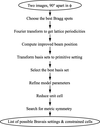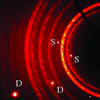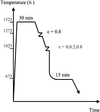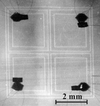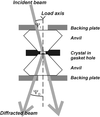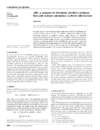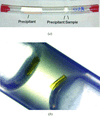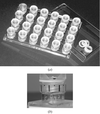issue contents
June 2004 issue

Cover illustration: Volumetric visualization of electron density surrounding a histidine residue, allowing for direct observation of discrete disorder; generated with POVScript+ and rendered with POVRay. Courtesy of T. D. Fenn, D. Ringe & G. A. Petsko [J. Appl. Cryst. (2003), 36, 944-947].
research papers
Bragg diffraction peak profiles and intensities in asymmetric diffraction using a mirror-based parallel-beam geometry were compared with symmetric parallel-beam and Bragg–Brentano diffraction for a powdered quartz sample and NIST standard reference material (SRM) 660a (LaB6).
In situ powder X-ray diffraction has been carried out in order to determine the mechanisms of formation of iron ore sinter phases and to investigate the effect of substitution of aluminium for iron in the process.
A commercially available small-angle X-ray scattering camera, NanoSTAR from Bruker AXS, has been modified to optimize its use for weakly scattering solution samples.
Integral breadth methods for line profile analysis are reviewed, including modifications of the Williamson–Hall method recently proposed for the specific case of dislocation strain broadening. Traditional and modified Williamson–Hall methods confirm their merits for a rapid overview of the line broadening effects and possible understanding of the main causes; however, quantitative results are generally not reliable.
The increase of trimethylgallium flow decreases dislocation density, especially edge dislocation density which acts as non-radiative recombination centres, and interface roughness, which improves the photoluminescence properties.
The viability of an alternative data collection strategy to rocking scans is investigated by using as test material a 50 Å thick NBCO thin film grown on an SrTiO3(001) substrate. The procedure, which is based on stationary L scans, i.e. the sample is kept fixed during the L scan, shortens the measuring time by an order of magnitude.
Open  access
access
 access
accessImproved methods for indexing diffraction patterns from macromolecular crystals are presented. The novel procedures include a more robust way to verify the position of the incident X-ray beam on the detector, an algorithm to verify that the deduced lattice basis is consistent with the observations, and an alternative approach to identify the metric symmetry of the lattice.
Download citation


Download citation


Open  access
access
 access
accessSome practical experience in the use of a three-circle diffractometer equipped with a CCD detector in single-crystal studies at high pressure is described.
The orientation relationships between austenite and bainite are examined by EBSD and represented in Rodrigues–Frank space. Neither the Kurdjumov–Sachs nor the Nishiyama–Wassermann relationship is followed exactly and austenite prior deformation causes variant selection.
Experimental test results on non-dispersive imaging with thick packets of silicon wafers are described and are compared with Monte Carlo simulations.
A method of correcting the asymmetry in the scattering of the tangential beam configuration in a rheo-small-angle neutron scattering experiment is proposed. The asymmetry of the scattering in the tangential beam configuration can be attributed to the difference in pathlength for neutrons that are scattered toward compared with those which are scattered away from the axis of rotation of the shear cell; the pathlength problem is solved and a final expression for the two-dimensional scattering intensity is given.
A kinetic description for different time laws in time-resolved X-ray diffraction experiments is derived in the framework of time-dependent correlation functions. The derived time laws were applied to time-resolved studies on a [2+2] photodimerization and a reversible reaction undergoing structural reorganization.
A new method is demonstrated in which a silicon single crystal simultaneously back-diffracts and detects the variation of the photon counting rate when the crystal is in and out of the X-ray back-diffraction condition.
Cold pressing of virgin copper single-crystal discs introduces anisotropy. Characterization by neutron diffraction shows that the twofold symmetry of the mosaic width of the pressed crystal is modulated by the 2π periodicity introduced by the precession of the reciprocal-lattice vector around the crystal face normal.
Download citation


Download citation


The crystal structure of the fragile glass-forming liquid m-toluidine (CH3C6H4NH2) has been solved ab initio at 150 K from powder X-ray diffraction. The crystalline cohesion is achieved by zigzag chains of N—H⋯N hydrogen-bonding networks, confirmed by minimization of the lattice energy.
Bragg–Brentano powder diffractometers equipped with fixed-divergence slits show a loss of intensity at small 2θ angles due to the overflow of the beam exceeding the sample surface. To correct this effect, geometrically derived algorithms are presented to calculate correction factors for circular sample surfaces, and it is shown how the beam intensity distribution can be taken into account.
cryocrystallography papers
An automated data-logging system was used to monitor the temperature inside a dry-shipper over a period of time in transit.
short communications
A digital CCD camera was modified and used to record many excellent X-ray topographic images quickly from single crystals of insulin.
computer programs
The methods for correcting single-crystal intensity data for absorption in diamond-anvil pressure cells are reviewed and a computer program that implements these methods is presented.
The expressions concerning the polarization in the three-beam case used in the program UMWEG are given.
The program ABS has been written to determine the absolute configuration by using anomalous scattering data. It also calculates a real-space figure of merit that can be used to assess the quality of the solution for anomalous scatterer sites.
laboratory notes
Techniques of crystallization of biomolecules in plastic fluorocarbon-formulated capillaries (Nalgene 870 PFA tubing) are presented.
Open  access
access
 access
accessThe modification and use of a crystallization plate for controlling the evaporation in hanging-drop trials is described.
Open  access
access
 access
accessA modified microdialysis button for use in protein crystallization has been designed and manufactured. This new apparatus, called the Microdialysis Rod, allows easier handling and storage, and provides versatility to the users.
computer program abstracts
The computer program JECP/SP, written in Java, for generating stereographic projections, possesses additional functionality applicable to specimen orientation adjustment using the specimen holder in transmission electron microscopy (TEM). The extension can be used to minimize the difficulties encountered when tilting highly beam-sensitive specimens, or small-grain-size specimens with known unit-cell parameters, in TEM experiments.
addenda and errata
Free 

It is shown that the recently presented scattering form factor for a cylinder with globular end-caps also contains the form factors for cylinders with spherically curved end-caps of any size.


 journal menu
journal menu














